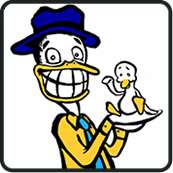There are tons of potential penalties waiting to happen in a hockey game. We're not going to list every single one, but these are the relatively common infractions. The first two (offsides and icing) deal with the zones that the players are in, while the rest deal with penalties for fighting or hitting each other.
Offsides: A player cannot pass forward (toward the opposing team's goal) to a teammate who is another zone except when the passing player is in the defending zone (behind his own blue line) and his teammate is in the neutral zone but has not passed the red (center) line. But if the passer and the receiver are both in the neutral zone (between the two blue lines), it's OK to pass the puck past the red line. To remind yourself what a hockey rink looks like, look at the bottom of this page.
Icing: Whenever a player shoots a puck from his side of the red line (center) into the attacking zone (that is, where the opposing team's goal is), it is called icing. The exception to this if the shooter is aiming for the opposing team's net.
Interference: This penalty describes a wide range of evils, but it mostly refers to the practice of impeding the progress of a player who is not in possession of the puck. A special sort of interference call is the penalty shot. If someone has a "breakaway" (that is, he's on the opponent's side of the red line and there is nobody between him and the goalie) and someone trips him up or otherwise impedes him from behind, he is supposed to be awarded a penalty shot. The clock is stopped and the player is allowed to skate, all by himself, from center ice towards the opposing goalie and take his best shot.
Charging: A charging penalty is assessed whenever a player "checks" (that is, skates into) another player with excessive violence after skating a long distance. This is mostly a judgment call on the part of the ref; they don't like to see a player line up another and chase him down at top speeds. This penalty can also apply if a player checks a goaltender. Goaltenders may not be checked, even if they leave their areas.
Cross-checking: Cross-checking occurs when a player smashes into another player with his stick held in both hands in front of his body.
Elbowing: You aren't allowed to stick your elbow out and hurt people. The league takes this pretty seriously. If a player receives a major penalty for an elbow, he also receives an automatic game misconduct and a minimum fine of $100.
Head-butting: If a player attempts a head-butt, he receives a double-minor penalty. If he actually does head-butt someone, he receives a major penalty. If the head-butted person is injured, the player receives a major penalty and a game misconduct.
High sticking: If a player's stick makes contact with another player above the struck player's shoulder height, a penalty will be assessed. This applies even if the contact was accidental, unless the contact occurred in the normal windup or follow-through of a shot.
Holding: A player is not allowed to hold onto an opponent with his hands, arms or legs. It's okay to use a hand to hold off a player by straight-arming him, but you can't grab or hold him.
Hooking: This penalty is assessed when a player uses the blade or shaft of his stick to impede another player's movement.
Roughing: A roughing penalty is assessed when players get feisty and hit each other or wrestle a bit, but leave their gloves on.
Slashing: This is one of those things that hockey players do all the time and are only penalized for occasionally. Slashing refers to the practice of hitting other players with your hockey stick.
Tripping: Just like it sounds, using either the legs or the stick.
SoYouWanna know more? Check out our full-length article SYW learn the basics of hockey?

